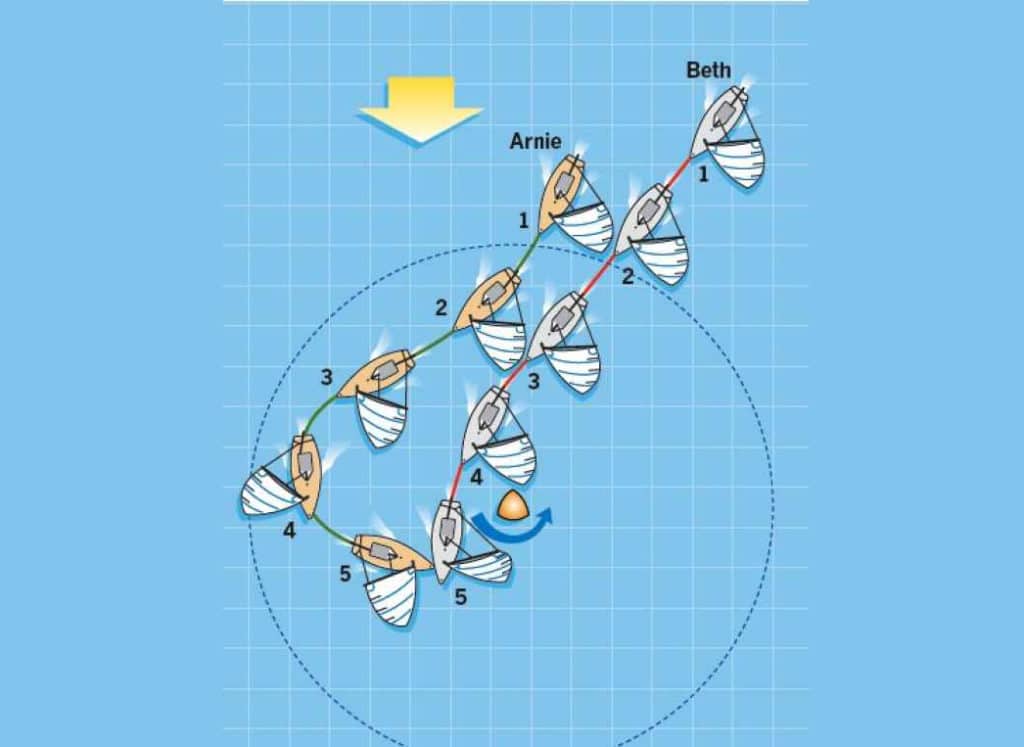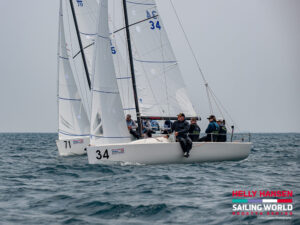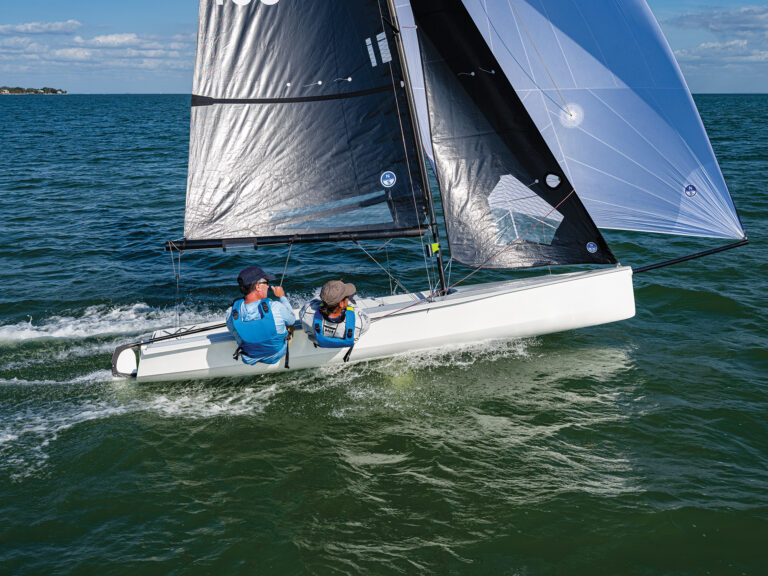
As you prepare for the 2012 season, it might help to review some key rules. I do that here by applying several basic rules to a deceptively simple situation that frequently occurs. I will analyze the situation step by step and explain who should, and who should not, be disqualified.
As shown in the diagram, Arnie and Beth, sailing Laser Radials, are broad reaching on starboard tack, approaching a leeward mark that they’re required to leave to port. At Position 5, there is contact. The wind is light, and the contact does not result in damage. Neither boat takes a Two-Turns Penalty. Each boat protests the other.
From Position 1 until Arnie jibes, he is clear ahead of Beth and, therefore, the right-of-way boat under Rule 12. At Position 1, when Arnie reaches the perimeter of the three-length zone, he becomes entitled to mark-room under the second sentence of Rule 18.2(b). From Position 1 until he jibes, Arnie is in a particularly strong position because he has right of way and, in addition, is entitled to mark-room.
What space is Arnie entitled to? Mark-room is room for Arnie to sail to the mark, and then room to sail his proper course while at the mark. There is a brand-new 2012 ISAF case (Case 118, based on a U.S. appeal) that clarifies what it means to “sail to the mark.” It states, “‘room to sail to the mark’ means space to sail in a seamanlike way to a position close to, and on the required side of, the mark. When the mark is abeam of the boat’s bow, and she is close to it, she has arrived at it.” Between Positions 2 and 3, Arnie’s bow is abeam of the mark, but he is over a length away from it and, therefore, not close to it. Arnie is still sailing to the mark at Position 5, so he remains entitled to room to sail to the mark throughout this incident. Note that, under the first sentence of Rule 18.2(c), Beth is required to continue to give Arnie mark-room even after she becomes overlapped inside him at Position 4.
Between Position 1 and when he jibes onto port tack, Arnie may sail any course he chooses and still maintain his right to mark-room. The only limitations on his choice of course are that, under Rule 18.2(c), he must stay in the zone and, under Rule 16.1, when he changes course he must give Beth room to keep clear. He easily complies with both.
Arnie chooses to sail a “tactical” course—sailing wide of the mark initially so that when he completes his rounding he will be very close to the mark and Beth will be either in his backwind or his blanket zone.
The fun begins right after Arnie jibes onto port tack. At that moment Rule 12 ceases to apply and Rule 10 begins to apply.
Right of way transfers from Arnie to Beth, who is still on starboard tack. However, as I said above, Beth continues to be required to give Arnie mark-room from Position 4 until the boats collide. For this reason, even though Beth is on starboard and Arnie is on port, Arnie remains entitled to space to sail in a seamanlike way to a position close to, and on the required side of, the mark. After he jibes, Arnie continues to sail to the mark. He does so by heading up toward a position close to the mark and on the required side of it. At Position 4, just after Arnie jibed, Beth could easily have luffed to give Arnie room to sail to the mark. She failed to do so and, instead, tried to sail between Arnie and the mark. Arnie continued to sail the course he was entitled to sail under Rule 18.2(b). The contact at Position 5 was the result.
Did either or both boats break any rules, and, if so, which rules were broken? Obviously Arnie made no attempt to keep clear of Beth between Positions 4 and 5, and so he broke Rule 10. Beth did not luff after Arnie jibed to give him room to sail to the mark, and so she broke Rule 18.2(b).
Rule 14 applies at all times and, in particular, between Positions 4 and 5. It requires both boats to avoid contact “if reasonably possible.” However, because Beth was a right-of-way boat and Arnie was a boat entitled to mark-room during that time, both of them enjoyed the right conferred by Rule 14(a) to delay taking avoiding action. Under that rule, Beth was not required to act to avoid contact until it was clear that Arnie was not keeping clear, and Arnie was not required to act to avoid contact until it was clear that Beth was not giving him mark-room. Beth could argue that she did not break Rule 14, because it did not become clear that Arnie was not keeping clear until just before the contact, by which time it was no longer “reasonably possible” for her to avoid contact. However, it was clear well before the contact occurred that Beth was not giving Arnie mark-room. Therefore, it was “reasonably possible” for Arnie to avoid contact by bearing off between Positions 4 and 5; Arnie broke Rule 14 and Rule 10.
Should one boat or both boats be penalized? Should boats be exonerated? Arnie broke Rule 14 but, because he was the right-of-way boat when he broke it, and because there was no damage or injury, he is not penalized for breaking it (see Rule 14(b)). Arnie also broke Rule 10 when he failed to keep clear of Beth at Position 5. Rule 10 is a rule of Section A. Rule 18.5(a) exonerates Arnie for his breach of Rule 10. “Translating” Rule 18.5(a) for our incident, we get, “While Arnie is taking the mark-room to which he is entitled, he will be exonerated if, as a result of Beth’s failure to give him mark-room, he breaks Rule 10.” Hence, under Rule 18.5(a), Arnie is exonerated for breaking Rule 10 and, as a result, is not penalized. Decision: Arnie is not disqualified, even though he broke two rules.
Beth broke Rule 18.2(b), and she did not take a Two-Turns Penalty after the incident. Rule 18.5 only exonerates a boat entitled to mark-room and never a boat required to give mark-room, and so Beth cannot be exonerated under that rule. Is Beth exonerated under Rule 64.1(c), an exoneration rule that is frequently overlooked? Beth could easily have given Arnie mark-room by luffing across his stern just after Position 4. For this reason, Beth was not compelled by Arnie’s actions to break Rule 18.2(b). Therefore, she cannot be exonerated under the Rule 64.1(c). Decision: Beth is penalized by being disqualified for breaking Rule 18.2(b).
This analysis has illustrated the steps that a protest committee must follow to reach a decision under the Part 2 rules:
Find the facts—determine the tracks of the boats involved leading up to and during the incident. Determine if there were any hails or if any boats took penalties under Rule 44.
Determine whether any boats broke any rules and, if so, which ones they broke.
Determine whether any boat qualifies for exoneration under one of the exoneration rules, Rule 18.5, 20.2, or 64.1(c). Also determine whether Rule 14(b) applies to any boat.
Finally, apply Rule 64.1(a) to disqualify any boat, or boats, that broke a rule and did not take a penalty, qualify for exoneration, or escape penalization under Rule 14(b).
Thanks to Ralph Roberts for this idea.









